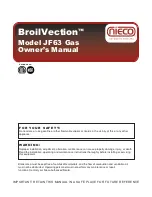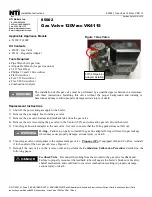
Burner Tray Removal
1. Shut-off power and gas supply to the boiler.
Disconnect union(s) and pilot tubing when pres-
ent; then loosen and remove burner hold-down
screws.
2. Disconnect wires at gas valve and slide burner
tray out.
Main Burner and Orifice Removal
1. Remove screws and burner hold-down bracket.
2. Lift burners from slotted spacer and slide from ori-
fices. Clean with a wire brush.
3. Orifices usually do not need to be replaced. To
clean, run either copper wire or wood through ori-
fice. Do not enlarge hole. To remove orifice, use a
socket wrench and remove the manifold. DO NOT
over-tighten when reinstalling.
NOTE:
If the heat exchanger is sooted badly, the
burner hold-down bracket and spacer can become
distorted from direct flame impingement and this
usually necessitates replacement of these parts.
REPAIR PROCEDURES
Tube Cleaning Procedure
(Typical)
Establish a regular inspection schedule, the frequency
of which depends on the local water condition and
severity of service. Do not let the tubes clog up solid-
ly. Clean out deposits over 1/16" in thickness.
To clean the tubes, remove the heat exchanger, ream
tubes and immerse heat exchanger in non-inhibited
de-scale solvent.
Heat Exchanger Removal
1. Shut water, gas and electricity off, close valves,
relieve pressure and remove relief valve. Remove
front inspection panel.
2. Remove top holding screws.
3. Remove draft diverter, lift and remove top and flue
collector on stack type models.
4. Loosen bolts and disconnect flange nuts on
inlet/outlet header, loosen union(s) at gas pipe,
and slide boiler away from piping until studs clear
the heater.
5. Lift heat exchanger straight up using caution not to
damage refractory.
Extension Pieces (5)
Auger with Carbide Tip
Wire Brush
RAYPAK TUBE CLEANING KIT
F
1
7
8
2
5
0
N
P
-
"
8
/
5
Fig. 31: Raypak Tube Cleaning Kit
NOTE:
In extreme cases it may be necessary to
remove the heat exchanger completely for cleaning.
The simplest method is steam cleaning at a local car
wash.
DO NOT WIRE BRUSH!
CAUTION:
Soot is combustible, so exercise
extreme care.
2. Remove "V" baffles from heat exchanger.
3. Remove burner tray, see Burner Tray Removal.
4. Take garden hose and wash heat exchanger, mak-
ing sure soot is removed from between fins. (Avoid
excessive water against refractory).
5. Reassemble; when boiler is fired, some steam will
form from wet refractory. This is normal.
30
Summary of Contents for 0042B
Page 14: ...VENT DAMPER 14 ...
Page 20: ...Wiring Diagrams 20 ...
Page 21: ...21 ...
Page 24: ...Fig 23 Power Vent System with Zone Valve Taco 24 ...
Page 25: ...25 Fig 23 Power Vent System with Zone Valve Honeywell ...







































